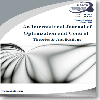Analysis of make-to-stock queues with general processing times and start- up and lost sales costs
Analysis of make-to-stock queues with general processing times and start- up and lost sales costs
___
- 1] Gavish, B., Graves, S.C., (1980). A one-product production/inventory problem under continuous review policy. Operations Research, 28(5), 1228- 1236.
- [2] Gavish, B., Graves, S.C., (1981). Production/inventory systems with a stochastic production rate under a continuous review policy. Computers & Operations Research, 8(3), 169-183.
- [3] Lee, H.S. Srinivasan, M.M., (1987). The continuous review (s, S) policy for production/inventory systms with Poisson demands and arbitrary processing times. Technical Report, 87-33.
- [4] Graves, S.C., Keilson, J., (1981). The compensation method applied to a one-product production/inventory problem. Mathematics of Operations Research, 6(2), 246-262.
- [5] Srinivasan, M.M., Lee, H.S., (1991). Random review production/inventory systems with compound Poisson demands and arbitrary processing times. Management Science, 37(7), 813- 833.
- [6] Altiok, T., (1989). (R, r) production/inventory systems. Operations Research, 37(2), 266-276.
- [7] Tijms, H.C., (1980). An algorithm for average costs denumerable state semi-Markov decision problems with application to controlled production and queueing system. In R. Hartley, L. C. Thomas, & D. J. White, Recent developments in Markov decision processes (pp. 143-179), Academic Press.
- [8] Heyman, D. P., (1968). Optimal operating policies for M/G/1 queuing systems. Operations Research, 16(2), 362-382.
- [9] Sobel, M.J., (1969). Optimal average-cost policy for a queue with start-up and shut-down costs. Operations research, 17(1), 145-162.
- [10] De Kok, A.G., Tijms, H.C., Van der Duyn Schouten, F.A., (1984). Approximations for the single-product production-inventory problem with compound Poisson demand and service-level constraints. Advances in Applied Probability, 16(2), 378-401.
- [11] De Kok, A.G., (1985). Approximations for a lost- sales production/inventory control model with service level constraints. Management Science, 31(6), 729-737.
- [12] De Kok, A.G., Tijms, H.C., (1985). A stochastic production/inventory system with all-or-nothing demand and service measures. Communications in Statistics. Stochastic Models, 1(2), 171-190.
- [13] De Kok, A.G., (1987). Approximations for operating characteristics in a production-inventory model with variable production rate. European journal of operational research, 29(3), 286-297.
- [14] Lin, H.J., (2017). Two-critical-number control policy for a stochastic production inventory system with partial backlogging. International Journal of Production Research, 55(14), 4123-4135.
- [15] Ha, A.Y., (1997a). Inventory rationing in a make-to- stock production system with several demand classes and lost sales. Management Science, 43(8), 1093-1103.
- [16] Bulut, Ö., Fadiloğlu, M.M., (2011). Production control and stock rationing for a make-to-stock system with parallel production channels. IIE Transactions, 43(6), 432-450.
- [17] Özkan, S., Bulut, Ö. (2020). Control of make-to- stock production systems with setup costs. Journal of the Faculty of Engineering and Architecture of Gazi University, 35(3), 1199-1212.
- [18] Ha, A.Y., (1997b). Stock‐rationing policy for a make‐to‐stock production system with two priority classes and backordering. Naval Research Logistics (NRL), 44(5), 457-472.
- [19] De Véricourt, F., Karaesmen, F., Dallery, Y., (2002). Optimal stock allocation for a capacitated supply system. Management Science, 48(11), 1486-1501.
- [20] Ha, A.Y., (2000). Stock rationing in an M/Ek/1 make-to-stock queue. Management Science, 46(1), 77-87.
- [21] Gayon, J.P., De Vericourt, F., Karaesmen, F., (2009). Stock rationing in an M/Er/1 multi-class make-to-stock queue with backorders. IIE Transactions, 41(12), 1096-1109.
- [22] Pang, Z., Shen, H., Cheng, T.C.E., (2014). Inventory Rationing in a Make‐to‐Stock System with Batch Production and Lost Sales. Production and Operations Management, 23(7), 1243-1257.
- [23] Yücel, Ö., Bulut, Ö., (2019). Control of M/Cox-2/s make-to-stock systems. An International Journal of Optimization and Control: Theories & Applications (IJOCTA), 10(1), 26-36.
- [24] Pervin, M., Roy, S.K., Weber, G.W. (2018). Analysis of inventory control model with shortage under time-dependent demand and time-varying holding cost including stochastic deterioration. Annals of Operations Research, 260(1), 437-460.
- [25] Tirkolaee, E.B., Goli, A., Weber, G.W. (2019). Multi-objective aggregate production planning model considering overtime and outsourcing options under fuzzy seasonal demand. In International Scientific-Technical Conference Manufacturing, (pp. 81-96). Springer, Cham.
- [26] Lotfi, R., Weber, G.W., Sajadifar, S.M., Mardani, N. (2020). Interdependent demand in the two-period newsvendor problem. Journal of Industrial & Management Optimization, 16(1), 117-140.
- [27] Paksoy, T., Özceylan, E., Weber, G.W. (2010). A multi objective model for optimization of a green supply chain network. In AIP conference proceedings (Vol. 1239, No. 1, pp. 311-320). American Institute of Physics.
- [28] Bose, S. K. (2002). Basic Queueing Theory. In An Introduction to Queueing Systems (pp. 9-54). Springer, Boston, MA
- ISSN: 2146-0957
- Yayın Aralığı: 4
- Yayıncı: Prof. Dr. Ramazan YAMAN
Multi-objective regression modeling for natural gas prediction with ridge regression and CMARS
Optimization of flexo process parameters to reduce the overall manufacturing cost
On a special case of non-symmetric resource extraction games with unbounded payoffs
Comparative assessment of smooth and non-smooth optimization solvers in HANSO software
Analysis of make-to-stock queues with general processing times and start- up and lost sales costs
Theory and applications of new fractional-order chaotic system under Caputo operator
